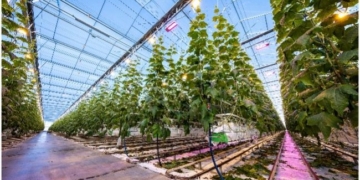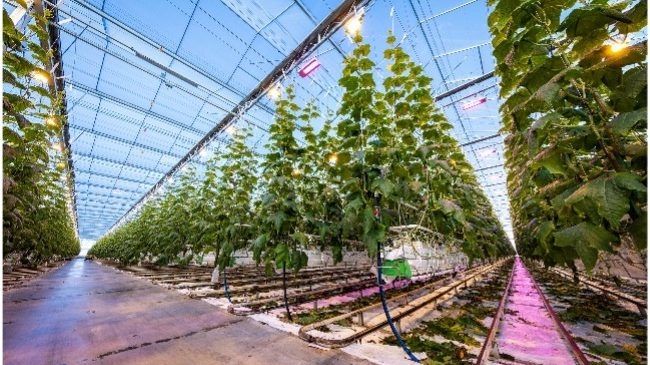Proven results and high Light Efficiency
Nunhem, the Netherlands – 7th October
As the main variety in the winter and spring crop under artificial lighting, Hi Power is rated highly for its stability. Even now that many growers are taking the first steps towards LED lighting, the variety continues to produce steadily. It also performs well under various light spectra and levels, say growers and experts.
Reliable Under All Types of Lighting
Anne Jancic, Global Marketing & Business Development High Tech at BASF vegetable seeds business, explains, “Hi Power is known for its effective use of light, be that SON-T lighting, full LED lighting, or a hybrid form. The variety is universal. You can get the best out of it under all circumstances, which gives growers the security they’re looking for – especially if they’re switching to other forms of lighting or altering the growing plan.”
Hi Power is very predictable under various light levels (from 80 to 250 micromole) and various light spectra (SON-T, LED, hybrid). “You always know what you’re getting. The fruit quality always meets the most stringent market demands,” says grower Huub van Wylick, who has run his farm in Maasbree, the Netherlands, with his wife Marlies for almost 35 years. “We have two separate cultivation systems: high-wire cultivation with 110-micromol lighting and a traditional cultivation department. Since this year, we’ve also been cultivating three crops a year on high-wire under artificial lighting, in order to save on labor and improve labor planning. Although high-wire cultivation is a big investment, it does significantly reduce the energy input per cucumber. There are lots of positive aspects to it.”
Van Wylick explains the various advantages. “Artificial lighting reduces the time to production, which has an added benefit for the staff. It means you can offer them more work earlier in the season, which creates a stronger bond. The variety is labor-friendly: Thanks to the plant’s open character, we’ll pinch stems later than before in order to reach the final stem density. This leads to a huge boost in quality as well as a reduction in labor.”
Hi Power is a reliable choice for Van Wylick, too: “We just know that Nunhems varieties are compact and labor-friendly. Hi Power has small leaves in a horizontal position, and the variety also delivers reliable quality in the winter months. The attractive, straight cucumbers fully meet the length and fruit weight requirements.”
Changing Lighting Conditions
Plant Specialists such as Erik Stappers from Signify have been working for some time on optimizing cultivation under LED lighting. “We’re in the optimization phase for cultivation under hybrid lighting, which is now ready for practical use in North-western Europe. For full LED, we still must make steps towards a large-scale practical introduction. The lighting and the variety must be a good match, as the differences between varieties are in this even greater than in hybrid lighting. There’s an increasing degree of interaction between the market and growers, and now things are speeding up towards a better and stable market for winter-grown cucumbers.”
Full LED gives growers more control over separating plant temperature and light, which enables them to make different choices in terms of plant elongation. LED means a crop can grow in a slightly more compact manner.” With Hi Power being a safe and trusted choice for many growers, it often played an important role as a reference in the trials. “It can achieve good results. Hi Power is an all-rounder, but it can also be optimized under just the right spectrum,” says Stappers.
Maarten Vliex, team leader of Botany’s expertise team, also thinks the time has almost come to grow under full LED. “We’re still fine-tuning which spectrum works best, and it’s important that genetics are in line with this. A spectrum may be sufficient for one variety and insufficient for another. There are differences.” Vliex explains how the four pillars of genetics, water management, climate, and lighting are the key to successful cultivation. “We should be aiming to connect those four.” They also used Hi Power in their trials. “Hi Power performed well and is easy to control in terms of generativity. That’s why we’ve chosen it as our standard crop.”
Start Your Three-Crop Cycle with Hi Power
As Hi Power performs well under high light intensities, it’s possible to start the first planting as early as October. That makes it a good plant with which to kick off a three-crop cycle. Marcel Huibers, Agronomist High Tech Cucumber at BASF vegetable seeds business, explains, “Strong, young crops yield more. Hi Power has now shown that the crop does extremely well in short cultivation cycles and even exceeds expectations. The uniformity is extremely good. A three-crop cycle also works out cheaper if virus levels are high.” Many growers combine the first crop with Hi Power with second and third crops with Hi Light.
And although three crops sounds like more work, Marcel says it isn’t. “It’s ultimately less labor-intensive to have three crops: the younger the crop, the less labor needed per cucumber.” That was also the experience of grower Huub van Wylick, who was pleased with the results after switching to three crops due to virus levels. “Labor is an area that quickly delivers huge cost savings if it becomes more efficient, and that’s what happened here. I achieve higher production than with two crops, plus I’ve lowered my costs.”
The Future of High-Wire Cultivation under Artificial Lighting
High-tech cucumber cultivation will evolve into a more connected, data-driven, automated, and sustainable production focused on consumer needs. The right set-up and approach to lighting will play an increasingly important role in this respect, along with other technologies and ensuring the right genetics. “At BASF we trial our genetics under different lighting regimes (light intensity, light spectra, duration of the artificial lighting per day) and constantly developing them further,” says Anne Jancic.
“In time, we’ll all go full LED. Some regions of the world are being forced to do so due to scarce energy supplies. Others are focusing on sustainable production for other reasons,” says Erik Stappers from Signify.
Maarten Vliex of Botany adds, “It’s also important to take a smarter approach to lighting in the future. For example, we should look at when energy prices or demands are low or explore constant production. Dynamic lighting also plays a role. In the future, we’ll look at the amounts of light and the color of the light in combination with genetics.”
If you want to know more about BASF’s vision of the future, have a look at their whitepaper On the Way to Smart, Automated and Consumer-oriented Cucumber Growing (looking ahead to 2030 and 2050). https://www.nunhems.com/gb/en/solutions/high-wire.html
For further information, please contact the cucumber sales specialists at BASF’s vegetable seed business:
Rens Muusers
Cucumber Sales Specialist
Mobiel +31-6-1871 9921
rens.muusers@vegetableseeds.basf.com
































